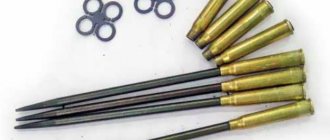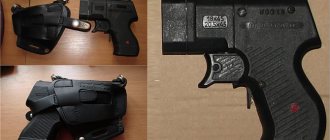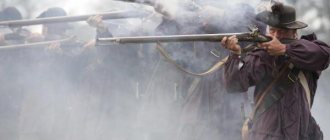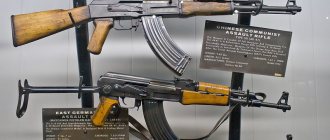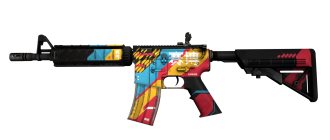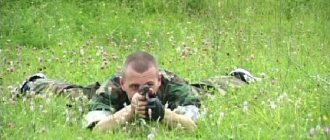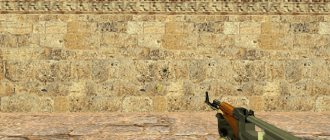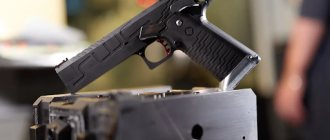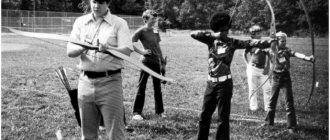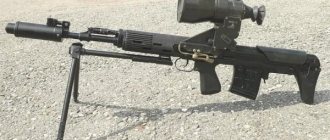Silencer PBS-4 and the exact principle of its operation
You will probably be interested to know how the PBS-4 muffler works and what the exact principle of its operation looks like, described step by step. It’s really worth talking about this in as much detail as possible, since this aspect of the operation of the described device is the most interesting from a technical point of view.
PBS-4, which many owners of their own cold or deactivated AK-74 assault rifle dream of buying, consists of a fairly thick steel tube screwed onto the muzzle of the barrel instead of the muzzle compensator, which reduced the level of recoil when firing in bursts. Powder gases, entering not immediately into the atmosphere, but into a chamber with many compartments fenced off from the central channel, managed to expand and cool. The metal quickly absorbed the excess heat of the powder gases, due to which, at the exit from the chamber of the silent firing device, they were too cold to cause an acoustic effect due to the speed of their expansion.
The PBS-4 silencer, which you can buy from us, had a complex obturation system that did not allow powder gases to overtake the bullet at the exit from the cooling chamber. The role of seals was played by rubber gaskets installed across the central channel of the muffler.
The PBS-4 silencer had a more thoughtful design than its predecessor, as a result of which it managed to take heat from the gases that accumulated in the chamber after firing several shots in a burst. An increase in noise level occurred only after ten to fifteen rounds were fired in a single burst.
The fact that the bullet itself leaving the silencer chamber did not cause any noise is the merit of the designers who developed a subsonic 5.45 caliber cartridge specifically for equipping silent variations of the AK-74. As a result, the only sound that could not be dealt with through the use of PBS-4, which can still be purchased today, was the sound of the interaction of moving parts and mechanisms of the machine gun - however, as for the AKM, equipped with an earlier first-generation silent firing device.
Unfortunately, like all many products of this type, the PBS-4, a muffler for the AK-74, required regular replacement of the seals to replace worn ones. As a rule, the need for additional maintenance of this product arose quite regularly, after only three or four cartridge magazines had been fired. Using a muffler with worn gaskets means observing an ever-increasing noise level from the shots fired.
However, in general, the PBS-4 muffler showed fairly solid reliability and durability parameters without the need for additional maintenance. He effortlessly coped with the tasks assigned to him, and was able to muffle not only the sound, but also extinguish the force of the flame resulting from the high temperature of the powder gases at the outlet.
PBS
What happened after the war? Our former allies began to abandon silent weapons. But in the USSR, on the contrary, they worked throughout the war and after it. This is how the legendary PBS-1 appeared. The task of developing the device was set by the military, who could no longer imagine fighting without reconnaissance units equipped with silent weapons in ambush, reconnaissance or at night. The development was undertaken by NII-61 (now TsNIITOCHMASH), which over the course of 5 years from 1950 brought the new device to the required characteristics. The result was, perhaps, the best universal silencer for standard combined arms weapons to this day. AKM and AKMS, equipped with this device, received the index “B” (silent) to their abbreviation. Even now in our army, many “specialists” prefer AKMB.
AKMS with PBS-1
The principle of operation of the PBS and its predecessor is common - the same cameras and shutters, but in larger quantities. A special cartridge with reduced speed, US-1, was also developed. As a result, the AKMB fired at 400 meters with good accuracy, and when it was not needed, the device was simply removed, and the battle could be fought with standard ammunition. None of our competitors have such a device yet.
PBS-1 disassembled
Analogues produced abroad can be called rather “sound moderators”, since the low-pulse 5.56 NATO cartridge remains supersonic, which greatly increases the noise level when firing. These “cans” on the barrel cannot be compared with PBS. Although there are already separate developments for the 300AC pistol or special cartridge, pistol calibers do not provide the necessary lethality, and the 300 caliber, which is generally similar to our US, is niche and cannot compete in versatility with similar characteristics.
Plug 5.45 mm
Replacing the Soviet standard 7.62-mm assault rifle system with a new 5.6 mm caliber (later 5.45 mm) also implied the development of a new silent system. Due to repeatedly changing technical requirements, this process dragged on for more than fifteen years.
PBS-2
In 1968, less than a year after the start of work on a new small-caliber assault rifle complex, research began on the topic “Development of a cartridge and device for silent and flameless shooting from a 5.6-mm assault rifle.” The research work was entrusted to the Klimov Central Research Institute of Precision Engineering (TSNIITOCHMASH). At the institute, V.I. was involved in the development of the cartridge. Efimov and V.A. Nikolaev, and the device was commissioned to be designed by A.S. I disagree. The purpose of the complex, like its predecessor, remains the same - reconnaissance and operations behind enemy lines.
The main requirements for the new silent complex were:
“- standard dimensions of the cartridge;
— weapons without changes;
— reliable operation of automation with cartridges with subsonic initial speed;
— complete lack of visibility of the flame from a distance of 50 m;
— ensuring penetration of the SSh-40 steel helmet at ranges up to 400 m;
— the accuracy of fire and dispersion elements can be 1.5 times greater than when firing with standard cartridges.”
Despite the performance almost equivalent to the AKM with the PBS-1, achieving some of them with the subsonic speed of a small caliber and weight bullet turned out to be a very difficult task even for experienced engineers. The main problems the experts had were with the operation of the weapon’s automation and the bullet’s penetration ability. The first versions of 3MZHU cartridges showed satisfactory accuracy, but they could not penetrate a steel helmet at the required distance.
Cartridge 5.45 US gunmag.com.ua
The cartridges were tested by firing from a 6P1-13 assault rifle (re-barrel AKM) with a PBS-MZh silencer (analogue of PBS-1). To achieve the required characteristics of the cartridge, the design of the bullet was constantly improved and refined. The Kazan Research Institute of Chemical Products (KNIIHP) tested various brands of powder charge, the best of which was P-45. However, even with the new version of the 2MZHU cartridge, the results were not impressive. Regular research projects were planned for both 1971 and 1972: “Development and research of a special 5.6-mm cartridge and devices for silent and flameless shooting from machine guns (A-3 or SA-006).”
The steel core of the new 22MSB cartridge began to be made hardened or heat-strengthened, and the charge was switched to P-125 gunpowder. Due to this, it was possible to achieve the required penetrating effect of the bullet. However, the time to celebrate success has not yet come. Due to the design of the silencer with rubber seals, the speed of the bolt frame was low, and after firing 200 rounds, the shortness of the bolt frame in the rearmost position was about 20 mm. It was even proposed to overcome this problem in such an exotic way as a two-bullet cartridge, the second bullet of which was borrowed from the 5.45 mm PSM pistol. However, this option often led to the second bullet getting stuck in the barrel.
By the end of 1972, based on the results of the research work carried out, the possibility and feasibility of developing a silent complex based on a 5.6 mm assault rifle was confirmed. The USSR Ministry of Defense included in the plan for 1973 experimental design work (R&D) on the topic “5.45 mm cartridge and PBS-2 device for silent and flameless shooting from a 5.45 mm machine gun.” At the same time, some points of the technical specifications have undergone changes in the direction of complexity: penetration of a steel sheet of 2.5-3 mm and an increase in the accuracy and stability of the battle when firing with a silencer.
PBS-2 Magazine "Kalashnikov"
Further refinement of the cartridge was carried out by specialists from TsNIITOCHMASH A.I. Bochin and L.I. Bulavskaya. To increase armor penetration, the core began to be made of carbide materials. Already at this stage, from a conventional cartridge with a reduced bullet speed (US) an expensive armor-piercing ammunition with a subsonic bullet speed was obtained. In addition, after the launch of AK74 assault rifles into mass production and Izhmash’s transition to the production of reduced barrels, the US cartridge, together with PBS-2, failed the next tests on almost all key points. It turned out that due to the rounding of the edges of the rifling bore of the reduced barrel, the friction force of the bullet casing increased. At low speeds of the US bullet and the long barrel of the AK74, the ballistics of the subsonic cartridge deteriorated significantly. Already in 1977, it was decided to develop a silent complex based on the promising shortened PP-1 assault rifle (future AKS74U).
However, attempts to make a full-size 5.45 mm machine gun silent were made for several more years. Thus, Izhmash specialists were asked to develop a methodology for selecting assault rifles for a silent complex from among the serial AK74. As a result of such manipulations, it turned out that only 30% of the weapons remained suitable for use with US cartridges. But even during the operation of specially selected machine guns, it turned out that with increasing firing rate, the effect of copper plating on the barrel bore increases, and cleaning the weapon does not lead to an improvement in the characteristics of the cartridge. In Izhevsk it was proposed to completely switch to the production of special machine guns for silent shooting with the assignment of a separate index, which would have a special barrel bore profile and a special coating. The final decision to use the silent complex of the standard AKS74U assault rifle as the base weapon was made at TsNIITOCHMASH only in 1980.
PBS-3
During 1980, tests of US cartridges, which by that time had received the GRAU 7U1 index, with the AKS74U assault rifle showed several advantages of a short barrel over a long one:
“- improving the stability of initial bullet velocities due to the shorter barrel length;
— improving the reliability of automation due to the displacement of the gas outlet to the treasury;
— improving the flight stability of bullets due to a smaller pitch of the rifling of the barrel bore.”
For the new machine, TsNIITOCHMASH also designed a new device, PBS-3. Having abandoned the use of rubber seals of the PBS-1 type to improve the accuracy of fire, the gas exhaust unit had to be modified to ensure the operation of the automation. A gas-dynamic accelerator was built into the design of the muffler, which began to interact with the elongated gas piston rod. However, with this design of automation, directly related to the operation of the silencer, firing with standard 7N6 cartridges using PBS-2 was excluded. At the same time, the silencer had a safety device to protect against accidental shooting with a 7N6 cartridge.
AKS74U with PBS-3 “Melee Weapons of Russia”
Another consequence of the abandonment of shutters was a lower level of reduction in the sound of a shot, which, nevertheless, remained within acceptable standards. The first tests of the new silencer with US cartridges gave very encouraging results. In comparison with the AKM complex with PBS-1, firing 5.45-mm US cartridges with PBS-3 had significantly greater firing efficiency, slightly better armor penetration results and an equivalent lethal effect. However, with all the advantages of this system, for its implementation it was necessary to make changes to the design of the machine gun, and firing a long burst of 7N6 cartridges led to failure of the PBS-3. TsNIITOCHMASH specialists urgently proposed another way to effectively suppress the 5.45 mm caliber.
PBS-4
By the time the development of the new PBS began, the development of the design of the 7U1 cartridge was almost completed. All that remained was to modify the muffler, the orbit of which in 1981 entered its third orbit. The design of the PBS-4 was of the same separator type as the PBS-3, but without a gas-dynamic accelerator - this made it possible to fire single and automatic fire with 7N6 cartridges. However, 7U1 cartridges had to be fired only in single shots with manual reloading after each shot. For reliable operation of the automation, the energy of the powder gases of the US cartridge was clearly not enough.
In the protracted story with the small-caliber automatic silent system, both the developer and the customer considered this situation acceptable. At the end of 1981, as well as the first half of 1982, GRAU conducted field tests of AKS74U assault rifles with PBS-3 and PBS-4 devices. The experts were servicemen from three military units of the GRAU, GRU and KGB of the USSR. Despite the unsatisfactory test results, the PBS-4 design was recognized as the most promising, noting a number of significant shortcomings:
“- unreliable reflection of the spent cartridge case during manual reloading, which often remained in the receiver and was difficult to remove from it;
— when shooting for 5 days without cleaning and lubrication, the parts of the device strongly burn to each other, for separation and disassembly of which a vice and a gas wrench are required, and a long exposure to gun lubricant for up to 15 days;
— when firing 7N6 cartridges, the fore-end heats up to 65-85 degrees and burns the shooter’s hand;
— the level of sound attenuation is greater than that of AKM with PBS-1 and at a temperature of minus 40 degrees reaches 155 dB;
- insufficient blocking effect of the bullet.”
Ukrainian special forces soldier with AKS74UB mil.in.ua
However, in 1982, a 5.45-mm silent complex with an AKS74U assault rifle with a PBS-4 device and a 7U1 cartridge was recommended for service with army special reconnaissance units instead of the standard 7.62-mm silent complex with an advantage in firing efficiency of 1, 2-1.8 times. The wearable ammunition for the fighter was approved in the amount of 30 rounds of 7U1, 120 rounds of 7N6 and 30 rounds of 7T3. Before the start of mass production, the developer had to eliminate all these shortcomings.
The system was refined at TsNIITOCHMASH from April to June 1983. A compensation device was introduced into the PBS-4 design to reduce dispersion when firing automatic fire and the volume of the second chamber was increased. The design of the elements of the cartridge case reflection system (bends, bolt cup, reflector tooth) and sighting devices have been changed in the machine gun. As a result, on August 11, 1985, the Minister of Defense signed order No. 0209 on the adoption of the AKS74UB (index 6P27) and AKS74UBN (index 6P27N) assault rifles, as well as the US cartridge (index 7U1), into service with the Soviet Army and Navy.
However, it was too early to put an end to the development of a silent 5.45 mm assault rifle. Serial production of ammunition was launched at the Voroshilovgrad Machine Tool Plant (later the Lugansk Cartridge Plant), which produced the first batch of mounting cartridges in 1984. The 7U1 cartridge underwent several technological changes (the main one was the replacement of the VK11 core alloy with VK8), and only in June 1989 did the technical documentation receive the highest letter “B”.
Three generations of silent assault rifles: AKMS with PBS-1, AKS74UB with PBS-4 and AS “Val” twower.livejournal.com
Despite the successful completion of such a long process of research and development, the silent 5.45 mm complex was destined for the unenviable fate of a low-volume product. The times of perestroika and the looming economic crisis did not promise bright prospects for the newly-made development - in particular, the Tula Arms Plant refused to produce assault rifles that differed from the AKS74U. Also by this time, the more promising 9-mm silent rifle VSS “Vintorez” and the AS “Val” assault rifle had appeared. The final chord of this entire symphony can be considered the acquisition of independence by Ukraine and the loss of the Lugansk cartridge plant from the production chain.
| Name | PBS-1 | PBS-2 | PBS-3 | PBS-4 |
| Weight, g | 630 | 280 | 610 | 1000 |
| Obturator mass, g | 34 | 18 | – | – |
| Weight of machine with silencer, kg | 3,80 | 3,43 | 3,42 | 3,80 |
| Length, mm | 200 | 125 | 220 | 240 |
Literature:
- Bushin Yu.V., Simonenko V.Yu. Russian small arms ammunition. Volume 2. Automatic, rifle and machine gun cartridges. — M., 2020
- V.N. Dvoryaninov. Small arms live ammunition. Book 3. Klimovsk: D'Solo - 2015
You drive more slowly...
So, about the design of weapon silencers. In order to understand the principle of operation of these devices, you need to understand the main sources of noise when fired. There are three of them in total: this is a loud bang that occurs with a sharp expansion of powder gases, leaving the barrel after the bullet under enormous pressure; the sound generated by the shock wave from a bullet flying at supersonic speed; as well as the metallic clang of moving weapon parts. Thus, in order to reduce the noise from a shot, you need to try to allow the powder gases to cool and expand as smoothly as possible. The way to deal with the second source of sound is obvious: you need to use special ammunition with a subsonic bullet, but at the same time allowing you to achieve sufficient lethality - in modern conditions, a bullet is required not only to hit the target, but also to overcome an obstacle in the form of a bulletproof vest or, for example, a vehicle body . For a bullet flying at low speed, this is only possible by increasing its mass, which, in turn, forces the use of large-caliber weapons. The third source of noise is countered by the use of plastics in special weapons or the use of non-automatic manual reloading systems, such as the English Welrod pistol of World War II.
De Lisla carbine The De Lisla carbine is a distant ancestor of silent special forces weapons, the first production model of a weapon with a multi-chamber integrated silencer chambered for a .45ACP pistol cartridge. The De Lisle carbine was used by British commandos during World War II. The loudest sound when using this weapon was the clicking of the bolt.
Now there are several types of designs of silent firing devices. Early examples of military suppressors were most often intended for production small arms. At the end of the 1930s in the USSR, the Mitin brothers designed one of the first serial expansion-type barrel silencers. The device was called "BrahMit" in honor of its inventors and was intended for installation on the Nagan revolver and Mosin rifle.
Muffler designs The diagrams show various options for implementing the design of mufflers (silent firing devices): a muffler with gas cut-off with rubber washers with cross-shaped cuts (4), a muffler with an obturation (3), a muffler with flow swirl using split washers (2), a deflector muffler with inclined washers (1).
The muffler was a cylindrical tube in which several rubber washers with cross-shaped slots for the passage of a bullet were hermetically sealed in series. On the sides of each washer there were two holes for releasing gases into the next chamber. After the shot, the bullet consistently moved the washers apart and came out, and the powder gases were retained by the partitions. The choice of weapon was also not accidental: the design of the Nagan is such that by “pushing” the drum onto the barrel and expanding the barrel of the cartridge case, the breakthrough of powder gases into the gap between the drum and the barrel is practically eliminated. An undoubted advantage was that the muzzle velocity of the standard Soviet revolver cartridge 7.62x39R was only 297 m/s: there was no need to create special ammunition, which would certainly have become scarce in war conditions. Things were less smooth with the Mosin rifle: to reduce the bullet speed of a powerful cartridge, it was necessary to reduce the powder charge, and fill the free space in the cartridge case with cotton wool.
A silent SP-4 cartridge was developed for the PSS pistol (“special self-loading pistol”). A cylindrical steel bullet with a copper leading band in the head, when loaded, is completely recessed into the steel cartridge case (flush with the cut of the cartridge case). The powder charge in front is covered with a piston-cap, which, when fired, pushes the bullet out, but itself cuts off the powder gases that remain inside the cartridge case.
"BrahMit" was widely and successfully used by both saboteurs and partisans. However, the application also revealed significant disadvantages of the device: the rubber washers wore out quickly and did not retain elasticity for long, and the device itself required frequent cleaning. In addition, the silencer was heavy, large in size and disrupted the balance of the weapon. The troops joked: “The BraMit device should be placed on the enemy’s head, which will prevent him not only from hearing the sound of the shot and seeing the flash, but also from seeing the face of the shooter.”
Cleaning and Lubrication
To clean and lubricate the muffler, use:
- all-season oil KRM - for cleaning the muffler and lubricating its parts in the ambient temperature range from plus 50 °C to minus 50 °C;
- RZh oil - for cleaning the muffler and lubricating its parts at ambient temperatures down to minus 50 ° C;
- RFC solution (barrel cleaning solution) for cleaning the surfaces of muffler parts (casing, support, head and separator) exposed to powder gases.
It is prohibited: to expose the separator parts to prolonged exposure to a radiofrequency solution in order to avoid corrosion of parts and destruction of the muffler. It is prohibited to: clean the seal with a radiofrequency solution to avoid destruction of the rubber plug.
- rags or paper KV-22 - for wiping, cleaning and lubricating the muffler;
- tow (short flax fiber), peeled from the kernels.
Note: The RFC solution is prepared in the amount necessary to clean the weapon within one day. Solution composition:
— water suitable for drinking — 1 l;
— ammonium carbonate — 200 g;
- potassium dichromate (chrompic) - from 3 to 5 g.
A small amount of RFS solution can be stored for no more than 7 days in glass containers, sealed with a stopper, in a dark place and away from heating devices. It is prohibited to pour RFC solution into metal lubricants.
It is strictly forbidden to use abrasive materials (sandpaper, sand, etc.) to clean the muffler.
The muffler located in the unit is cleaned:
- in preparation for shooting;
- after shooting - immediately after the end of shooting at the shooting range (in the field). It is recommended to clean the silencer after every 200 shots. At the same time, the casing, support, head and separator are cleaned and lubricated. Final cleaning is carried out upon returning from shooting and daily for the next three to four days;
- after duty and training in the field without shooting (upon returning from duty or training);
- after march or transportation;
- in a combat situation and during long-term exercises - every day during periods of calm in the battle and during breaks in exercises.
After cleaning, lubricate the muffler. Apply lubricant only to a well-cleaned and dry metal surface immediately after cleaning to prevent moisture from affecting the metal.
In a barracks or camp location, cleaning an assault rifle with a silencer or silencer should be carried out in specially designated places, on tables equipped for this purpose, and in a combat situation and during exercises - on clean mats, boards, plywood, etc.
At the shooting range, after shooting, clean the muffler in the designated areas with RFC solution or oil.
The muffler, lubricated with oil at the shooting range, must be cleaned with an RFS solution after returning to the barracks.
In field conditions, cleaning and lubrication is carried out only with oil.
Clean the muffler in the following order:
- prepare materials for cleaning and lubrication;
- prepare the accessory in accordance with the operating manual for the machine gun, regarding cleaning the barrel bore.
- disassemble the muffler;
- if necessary, clean the surfaces of the muffler parts that are not exposed to powder gases with oil, then wipe dry with a rag;
- apply the RFC solution to the inner surface of the casing using a previously prepared accessory from the machine, remove the remaining carbon deposits along with the RFC with an oiled rag, then wipe dry with a clean rag;
- wash the separator, support and inner surface of the head with RSF solution, clean the parts with an oily rag, then wipe dry with a clean rag;
It is prohibited to expose muffler parts to prolonged exposure to radiofrequency solution to avoid corrosion and destruction of the muffler.
History of creation and improvement
The need to create a silencer arose in connection with a change in the tactics of rifle units in the early 50s. As stated in the terms of reference for the development, the main goal of creating a PBS
— ensuring successful combat operations in ambush, reconnaissance, night combat conditions and behind enemy lines. Simultaneously with the silencer, NII-61, under the leadership of designer M.A. Kuzmina, began the development of a new range of 7.62x39 mm ammunition with a reduced muzzle velocity, and the creators of the cartridge arr. 1943 N. M. Elizarov and B. V. Semin.
By December 1954, work was completed on:
- drawings of a 7.62 mm cartridge mod. 1943 with a reduced muzzle velocity,
- drawings on PBS
for SKS, AK, and RPD, - project TU NII-61 MOP for the production and acceptance of a batch of 7.62 mm cartridges with a reduced muzzle velocity,
- drawings of inspection tools for mass production of the cartridge,
- calculations for the fit of a new cartridge into the chamber.
In addition, a pilot batch (30,000 pieces) of 7.62 mm ammunition of the 1943 model with the US OP02-E-61 bullet was assembled, 6 copies of PBS
for SKS, AK and RPD, and also - the development of a factory testing program has been completed.
From December 16, 1954 to January 20, 1955, factory tests of the PBS
and new ammunition for it. The results were considered satisfactory.
From February 18 to March 18, 1955, field tests of the PBS
and ammunition for it. To compare the indicators, standard rifles of the 1891/1930 model with Bramit silencers and RP-46 machine guns with standard silent firing devices were used. The results were considered unsatisfactory to the requirements of TTT GAU No. 006029 for a number of parameters: the effectiveness of suppressing the sound of a shot, smokelessness, combat stability, survivability of seals, etc.
It took 8 months to eliminate the identified deficiencies; for this, the design of the device was completely redesigned. In addition, the design of the US bullet underwent some changes, for example, to increase the penetrating effect, a steel core was introduced and the diametrical dimensions of the leading part were adjusted.
In December 1955, repeated factory tests were carried out at NII-61, which were considered successful.
In the period from February 13 to April 14, 1956, repeated field tests of the PBS
, which, despite a number of unresolved problems, were also considered successful. The report recommended the device for military testing.
Despite the adoption of the PBS
into service, refinement of aiming angles over the entire range of fire contact distances continued at the GRAU and
NII-61
until the end of 1957.
Military tests took place in 1958, it was found that equipping the crews of RPD light machine guns with PBS
impractical from the point of view of tactics of combat use, and
the PBS
under the SKS was not recommended for production due to the fact that the self-loading carbine fell out of the new infantry weapon system.
Initially, the production of PBS
together with ammunition, the US was deployed at the facilities of
NII-61
.
In 1962, with some modifications, under the designation PBS-1
it was transferred to the Izhevsk Machine-Building Plant.
US
cartridges was transferred to plant No. 711 (Klimovsky stamping plant).
A set of measures was carried out to finalize the PBS
never made it possible to cope with its main disadvantages: high gas pollution (smoke) in the area of the shooter’s position, unstable operation of the gas engine of the machine gun and insufficient fire accuracy, which caused an increase in interest in shooting systems with integrated silencers. Work in this direction led to the emergence of AS VAL and VSS Vintorez.
At the beginning of the 21st century, design solutions used in PBS
, after some modification, found application in silencers for AK family assault rifles supplied by third-party developers to the civilian arms market in the United States.
Replacing the seal in the muffler
The shutter ensures reliable operation of the machine's mechanisms until 200 rounds are fired and after that it must be replaced. The shutters are replaced with new ones in cases where a sharp deterioration in the accuracy or accuracy of shooting is noticed, as well as when delays occur during the operation of the machine gun.
To remove the seal you should: separate the magazine from the machine gun; check that there is no cartridge in the chamber; remove the muffler from the machine, unscrew the casing from the head by squeezing the casing latch, remove the support with the seal from the head, remove the used seal.
Install a new seal. Assemble the silencer in the reverse order and install it on the machine gun, and then you should check the normal firing of the machine gun and, if necessary, bring the machine with a silencer to normal fire.
When replacing the seal at an air temperature below minus 20 ° C, it is necessary to make great efforts when screwing the casing into the head to ensure normal compression of the seal rubber.
Design
Structural product PBS
is a hollow metal cylinder made from two half-cylinders that are hinged together for ease of access and routine maintenance. In the cavity of each half-cylinder there are 12 steel semi-circular partitions, which are attached to the half-cylinders by caulking into radial grooves. The connection between the housing and the muffler head is carried out by thread. The seals were made of frost-resistant rubber (mixture 4RI-304A based on SKBM rubber) and consisted of a solid rubber plug inside a metal casing.
PBS instrument heads
for the SKS carbine and the RPD machine gun differed only in the attachment point to the barrel of the weapon.
To do this, the carbine had a clamp with a pressure screw, and the machine gun had flats for a wrench. The head of the device for the AK assault rifle was equipped with an additional expansion chamber in the form of a cover that was screwed onto the head pipe connecting the PBS
to the barrel of the weapon.
Pickup
Every day from 10 am to 6 pm (7 days a week) It’s easy to find us at Prospekt Mira 119 building 501 (1st floor). Pavilion 501 is bright green, on the left side of the rocket (industry square) opposite the registry office and next to the washer grocery store »
Show room for dismantled weapons. Serebryakova passage, house 6 Business center. Pickup of blank cartridges and cooled weapons only by prior arrangement!
You can buy knives, telescopic batons, blank cartridges, cold weapons, self-defense gas cartridges, etc. at the address: Moscow, VDNH, territory of the All-Russian Exhibition Center (VDNH) Page 501 from 10-00 to 18-00 (weekdays) and from 10-00 until 19-00 (weekends)
Design of PBS (military silencer for AK)
The Soviet PBS (Silent Shooting Device) was put into service in 1956 after a series of lengthy tests and a number of modifications to pre-production samples. The PBS for AK has a very interesting design; albeit not without shortcomings, but still working to this day (provided that special subsonic cartridges are used). PBS for AK consists of a collapsible body, inside of which there is an expansion chamber, a seal, and a separator.
Expansion chamber. Located in front of the shutter, just like the first chamber of the muffler, Rotor 43 takes on the maximum pressure of the powder gases. But only the muffler for the AK Rotor 43 has communication with the atmosphere through the gas release holes, and in the PBS the expansion chamber works as a temporary storage of powder gases, which after the shot are vented back through the holes towards the shutter and mainly go into the barrel, receiver, gas return unit, significantly increasing their pollution.
Obturator. This is a rubber/rubber washer, the new seal does not have a channel for the bullet, the channel appears on the first shot, from this we can conclude that the bullets must pass through the seal very tightly. The shutter is the most short-lived part of the PBS; in fact, it is a consumable that lasts no more than 200 shots, after which it must be replaced. In addition, as the shutter wears out, the average point of impact (MAP) shifts, which imposes its own limitations.
Separator. This is simply a set of washers, which is designed to separate into parts the flow of powder gases following the bullet. The washers are made flat without any complications; there is no such geometry as the washers in the muffler for the AK Rotor 43 - it would be too expensive.
Maintenance
Attention: to maintain the muffler, separate the magazine from the machine gun, make sure that there is no cartridge in the chamber, and separate the muffler from the machine gun.
When operating the muffler, it is necessary to carry out its technical inspection in a timely manner.
There should be no cracks, dents, bent separator partitions, traces of corrosion or other defects on the muffler parts.
The muffler is disassembled for technical inspection, cleaning, lubrication, replacement of the seal and repair of faulty parts, and the following rules must be observed:
- Disassemble and reassemble the muffler on a table, bench, or in the field on a clean mat;
- When disassembling and assembling, do not use much force.
During the technical inspection it is necessary:
- check the completeness of the muffler;
- inspect the muffler in assembled and disassembled form.
See also Edit
| Weapons and equipment | ||
| Counter-Strike • Counter-Strike (Xbox) • Counter-Strike: Condition Zero • Counter-Strike: Source | ||
| Melee | Knife | |
| Pistols | P228 • Desert Eagle • Dual Beretta 96G • Five-seveN • Glock 18 • USP | |
| Shotguns | XM1014 • M3 | |
| Submachine guns | MP5 • MAC-10 • TMP • P90 • UMP45 | |
| Assault rifles | AK-47 • AUG • FAMAS • Galil • M4A1 • SG 552 | |
| Sniper rifles | AWP • Scout • SG 550 Sniper • G3/SG-1 | |
| Machine guns | M249 | |
| Equipment | Basics | C4 Explosives • Sapper's Kit • Body Armor/Vest + Helmet • Silencer • Flashlight • NVGs • Tactical Shield |
| Grenades | Frag Grenade • Flash Grenade • Smoke Grenade | |
| Counter-Strike: Global Offensive | ||
| Melee | Knife • Golden Knife • Bayonet • Butterfly • Falchion • Folding Knife • Hook • Knife • Karambit • Knives • M9 Bayonet • Knife • Bear Knife • Navaja • Claw • Stiletto • Classic knife • Paracord • Hobo • Survival knife • Skeleton knife • Zeus x27 | |
| restricted area | Ax • Hammer • Wrench • Fists • Demolition Charge • Tablet • Medical Syringe • Thrust Mine • Exo Jump • Ballistic Shield | |
| Pistols | CZ75-Auto • Desert Eagle • Dual Berettas • Five-SeveN • Glock-18 • P250 • P2000 • R8 Revolver • Tec-9 • USP-S | |
| Shotguns | MAG-7 • Nova • Sawed-Off • XM1014 | |
| Submachine guns | MAC-10 • MP5-SD • MP7 • MP9 • P90 • PP-19 Bison • UMP-45 | |
| Assault rifles | AK-47 • AUG • FAMAS • Galil assault rifle • M4A4 • M4A1-S • SG 553 | |
| Sniper rifles | AWP • G3SG1 • SSG 08 • SCAR-20 | |
| Machine guns | M249 • Negev | |
| Equipment | Basics | C4 Explosives • Sapper's Kit • Rescue Kit • Body Armor/Vest + Helmet • Silencer |
| Grenades | Frag Grenade • Flash Grenade • Smoke Grenade • Decoy Grenade • Incendiary Grenade • Molotov Cocktail | |
| Joint raid | Ammo Cache • Collectible Coin • Grenade Case • Heavy Armor • Medical Syringe • Tactical Grenade | |
| Other | Ammo Can • Grenades |
Muffler design for AK Rotor 43
a muffler for an AK is based on
Rotor 43 - specially shaped partitions that form chambers inside the muffler housing. The main idea is that powder gases fall into the “trap” by swirling around the partitions.
It’s difficult to explain in words, it’s better to look at an illustration from patent documents:
This is why Rotor 43 mufflers have such high efficiency with adequate external dimensions. This principle was developed and patented by D.V. Gritsenko. - founder and owner with the call sign Rotor 43 during his service in the special forces. The design of the muffler for the AK Rotor 43 does not have a seal or other parts that come into contact with the bullet and are subject to wear, or at least somehow affect the flight of the bullet, etc.
On the Internet you can find the opinion, also replicated by “armchair analysts,” that all Rotor 43 mufflers have the same filling. This is wrong. Even using the example of AK-shaped mufflers, you can see that for 7.62x39 there is one geometry of chambers and partitions, for 5.45x39 there is another, for 366 TKM there is a third. Or can you imagine that we use partitions for .366 caliber for 5.45x39?! In the case of the geometry of chambers and partitions made according to the Rotor 43 principle, a simple change in the internal diameter is not enough, since a change in caliber in any case entails a change in geometry: after all, our mufflers do not have flat washers. In addition, modern mufflers for AK Rotor 43 are manufactured with a gas discharge system integrated into the first chamber, which makes them gas-unloaded. There is a corresponding article about what it is and more. The AK silencer Rotor 43 is designed to work with any cartridges that are approved for each specific AK variant.
The use of special subsonic cartridges with less powder and heavier bullets is not required (and where would civilians legally obtain such ammunition...).
Disassembly and assembly of the muffler
Attention: To maintain the muffler, separate the magazine from the machine gun, make sure that there is no cartridge in the chamber, and separate the muffler from the machine gun.
The muffler is disassembled after separating it from the machine, for which:
- in accordance with Figure 9, place the machine gun with the butt down between the feet;
- press down the latch and, grasping the muffler with your hand and rotating it counterclockwise, unscrew the muffler from the machine.
Muffler disassembly sequence:
- separate the head from the casing: take the muffler in your right hand and with the thumb of this hand press the latch to the casing, and with your left hand, turning the head counterclockwise, unscrew the head;
- remove the separator from the casing by taking the casing in your left hand, and tilting it, shake it out or squeeze the separator out of it with the fingers of your right hand.
The separator cannot be disassembled:
- remove the support from the head, and, if a seal was installed in the muffler, remove it from the support.
The muffler is assembled in the following order:
- insert the separator into the muffler casing;
- install the support into the head (if necessary, install the seal into the support first);
- attach the head to the casing: holding the casing with your right hand, screw the head onto the casing with your left hand, rotating it clockwise.
Screw the head onto the casing until the separator stops against the support; if the protrusion of the latch is not fixed in the recess of the head, the head should be unscrewed to fix it to the recess closest to it. A slight movement of parts inside the muffler is normal and is eliminated when installing the muffler on the machine.
Screwing the head, with the seal installed in the support, must be done with hand force in order to tightly press the rubber of the seal. After screwing the head, you need to make sure that the protrusion of the latch is fixed in the recess of the head;
- attach the muffler to the machine.
Special aiming bar with clamp
A special sighting bar with a clamp (Fig. 5) is placed on the base of the machine gun sight instead of the standard sighting bar. It is used to aim the machine gun at the target when firing at various ranges with both “US” cartridges with a device for silent and flameless shooting, and with ordinary cartridges mod. 1943 without device.
Sighting bar
It has divisions on the upper plane with numbers from 1 to 10 and a division with the letter P for firing ordinary cartridges. On the reverse side of the sighting bar (on the lower plane) there are divisions with numbers from 1 to 4 for firing “US” cartridges.
A movable rear sight 5 is mounted in the sighting bar bushing, which moves in the transverse direction to the right or left with the corresponding rotation of the lock 4.
The clamp of the sighting bar has a pressure 8 for removing the clamp from the cutouts of the sighting bar when pressed with the fingers.
The clamp heads have six teeth of different heights. Against each tooth there are numbers indicating the height of the tooth.
Rice. 5. Special sighting bar with clamp:
1 — sighting bar; 2 - clamp; 3 — right clamp head; 4 — rear sight lock;
5 — movable rear sight; 6 — left clamp head; 7 — head clamps; 8 — clamp bend;
9 — pin for fixing the heads of the clamp; a - axles; b - teeth of the heads
Rice. 6. General view and parts of the PBS device:
1 - body; 2 — head cover; 3 - base of the head; 4 - shutter
Rice. 7. Body (folded and opened) of the PBS device:
1 and 2 - half-cylinders; 3 - axes; 4 - latch; a - partitions; b - thread for connecting to the head
When installing the sight for firing US cartridges, the teeth of the heads with the same numbers rest on the sectors of the sight. The teeth are selected when bringing the machine gun into normal combat by firing “US” cartridges.
To fire from a machine gun with ordinary cartridges, the heads of the clamp are moved to the sides from the center of the sighting bar and fixed by turning them on pin 9, while the clamp with its spherical surface rests on the sectors of the base of the sight.
For PBS devices (Fig. 6 and 7), manufactured before 1962, the body (Fig. 7) consists of two semi-cylinders 1 and 2, interconnected by axes 3. In the cavity of each semi-cylinder there are twelve partitions a with semicircular cutouts in the center for the passage of a bullet. The first partition is somewhat thicker than the others and serves as a stop for the seal.
On the outer surface of the semi-cylinders there is a thread for connecting the body to the head. To prevent the body from unscrewing itself, a latch 4 in the form of a leaf spring is riveted to one of the half-cylinders.
The design of the head, shutter and special sighting bar remained unchanged.
Firing from an AKM assault rifle with the PBS-1 silent firing device.
The PBS-1 silencer is very effective; the sound level of a shot is reduced by 20 times. For example, a 7.62 mm AKM assault rifle, equipped with one of the PBS-1 modifications, shoots no louder than a 5.6 mm sports rifle. Checking the combat and zeroing the weapon is carried out after installing the next shutter and firing several shots to form a bullet channel.
As the shutter wears, the midpoint of impact shifts due to changes in shot conditions. Since the ballistic characteristics of the US cartridge bullet differ significantly from ordinary ones, the aiming bar of the sector sight of the AKM assault rifle was replaced with a special one with a clamp and a completely adjustable direction. Depending on the installation of the clamp heads, the rail was used to fire a US bullet or an ordinary cartridge.
Based on materials from the book Devices for reducing the sound level of a shot for machine guns. Konovalov N.A., Pilipenko O.V., Skorik A.D., Kvasha Yu.A., Kovalenko V.I.
Where to find? Edit
PM Edit
- Cordon is a metal case on the roof of a brick elevator building near the railway bridge.
- Cemetery of abandoned equipment - a metal case in KamAZ.
- Agroprom - caches “Box on the roof”
,
“At three tanks”
and
“Fitter’s inventory”
. Tips for hiding places drop from the corpses of loners and bandits in the Agroprom Research Institute and Agroprom Dungeon locations. - The “100 X-ray” bar is part of the reward from the Bartender for the quest Find the “Goldfish” artifact.
- Dark Valley - Hidden Safe cache
. - Wild territory - very rarely on mercenary rifles.
CHN Edit
- On sale from Suslov after the capture of the Renegade base.
- In some hiding places.
- On sale at Ashot.
- Mounted on mercenary rifles.
- Gives Ganja as a reward for capturing the Debt base.
Salary Edit
- Available from Sych and Hawaiians.
- In the Pripyat-1 overpass near the green booths.
- Rarely do stalkers have it attached to a weapon.
- Mercenaries often carry them on their weapons.
- Installed on the Viper-5 of Goblin and Lawn, as well as on the TRs-301 of Cleaver and Hook.
- Occasionally Svoboda members have Vipers-5 and TRs-301, along with sights.
- Installed on SIP-t M200 pistols of Monolith veterans in the overpass and in Pripyat.
Tactics Edit
Remember that the suppressor greatly reduces USP damage, and increases the damage loss with distance of the M4A1, so be sure that with the suppressor installed you will be fighting close, or trying to get headshots at long ranges.
The silencer should be removed due to decreased accuracy at long distances.
The suppressor does not affect spread or recoil in Counter-Strike: Source, rest assured that it is installed to increase damage.
Keep the suppressor installed on the USP-S and M4A1-S because... this greatly improves accuracy and reduces spread. Removing the suppressor will make these weapons less effective than their unsuppressed counterparts (P2000 and M4A4 respectively).
Remember that a silencer does not affect the weapon's rate of fire, so the danger to players with this device is not reduced.
The advantages include the M4A1's high close-range damage and reduced weapon noise, which makes it more difficult to find the shooter.
A silencer merely reduces the noise of a weapon, not eliminates it. Enemies nearby will still be able to hear the gunfire unless it is interrupted by a louder sound.
The suppressor conceals the weapon's flame, allowing the shooter to remain hidden longer in dark places. However, bots do not follow this rule, and will see the shooter as if there was no darkness at all.
If you think there is a crowd of enemies nearby that suspect you are there, throw a flash grenade and a smoke grenade.
The flash grenade does not affect players' hearing, it is important to act quickly and disorientate enemies by shooting at them. and start shooting with silenced weapons.
Running will reduce the effectiveness of the muffler because
enemies can hear you. It is better to crouch/walk when entering enemy territory.
In missions, enemies can detect you despite reduced weapon noise. Although the advantage of stealth is lost, you can use the increased damage.
Be sure that the silencer is installed before attacking, because The attachment process will take time, leaving the player defenseless.
It is worth noting that suppressed weapons do not provide much of an advantage in open space unless the enemy is aware of the shooter's location or the shooter is capable of headshots. (all except)
Bots will randomly attach a silencer, making them unpredictable.
Storage and transportation
The storage area for mufflers must be dry, without sudden fluctuations in temperature and humidity, and ensure reliable preservation of the products.
It is not allowed to store mufflers indoors together with phenols, concentrated acids, alkalis, organic solvents and other substances that destroy rubber.
Silencers should be stored in the manufacturer's containers.
It is allowed to store machine guns with installed silencers in a pyramid.
Silencers in manufacturer's packaging are transported by any type of transport without speed or distance restrictions, using protective measures against direct exposure to precipitation.
When driving, it is allowed to carry the machine with the muffler installed, in a position that excludes the possibility of damage to the muffler or the ingress of liquids, sediment, soil or foreign objects into it. Shelf life in manufacturer's containers is 7 years.
You can buy the PBS-4 muffler only from us!
If you want to become the owner of this rather rare product on sale, then hurry up - you can only buy the PBS-4 muffler from us, and the offer is seriously limited!
This product, although it cannot be used to equip a civilian with a real Kalashnikov assault rifle chambered for 5.45x39 mm, is perfect for installation on any weight-and-size model or a cold AK-74 assault rifle.
This product has a fairly high level of quality and is an original product produced by the Izhevsk Machine-Building Plant, which previously operated as a defense enterprise. Expert assessment allows us to evaluate the operational condition of the described product as ideal: the product is free of any defects, both structural and visual
If you really need a PBS-4 muffler, then you will certainly pay close attention to our offer. High quality of the product and a fairly reasonable price are the main reasons not to think twice about purchasing
Silent firing devices PBS and PBS-1 are multi-chamber expansion type silencers with cut-off (obturation) of powder gases. The PBS-1 device is screwed onto the end of the barrel of AKM assault rifles.
Next, the powder gases, under pressure, are released into the surrounding space through four small holes located inside the housing. The holes communicate with the external environment through a narrow gap 0.2 mm wide. The gas stream, first hitting the wall opposite the hole, is reflected from it and goes out.
Powder gases, cut off by a rubber stopper, create a pressure sufficient for the operation of the weapon’s automation, compensating for the weakened charge of the subsonic special US cartridge used with the PBS-1. The bullet, having pierced a hole in the rubber stopper, passes through the holes of eleven expansion chambers. Powder gases that break through after the bullet before the rubber closes lose speed and pressure, successively passing through the expansion chambers.
The seal is crimped with a metal clip, which should protect it from swelling during operation and facilitates replacement. Data on the service life of one shutter when firing with PBS are very contradictory. Values are indicated from 20-30 shots to 100 and even 200. After 20-30 shots, the effectiveness of PBS jamming begins to drop noticeably.
Structurally, the PBS-1 muffler went through two stages of creation. Initially, the PBS device for the AK assault rifle included a housing, onto the back of which the head was screwed. The body consisted of two semi-cylinders, hingedly connected by axles in the front part. The head fastened the half-cylinders, while twelve jumpers made in the cavity of each half-cylinder formed transverse partitions with holes for the passage of a bullet.
The head, including a seal with a rubber plug in the holder, the pipe on its base had an internal thread for mounting on the muzzle of the barrel, and a disc spring prevented self-screwing. The design of the PBS housing was easy to manufacture and maintain, but did not provide proper tightness. Since 1962, the design of the PBS housing has become non-detachable, and a separate separator inserted into the housing was also introduced.
The separator was assembled on three longitudinal rods, fastened with front and rear rings. Ten partitions were attached to the rods; they were kept from moving by bushings placed on the rods. The rings and partitions had holes for the free passage of bullets. The device received the PBS-1 index.

